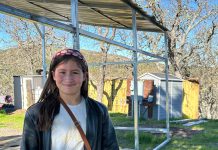Let’s sit and talk about the weather
As the skies opened up last week, a few coworkers and I gathered
under and overhang, drinking it all in, so to speak.
”
Can anyone who grew up in a dry place ever take the rain for
granted?
”
I asked nobody in particular.
The answer, it would seem, is no.
Let’s sit and talk about the weather
As the skies opened up last week, a few coworkers and I gathered under and overhang, drinking it all in, so to speak.
“Can anyone who grew up in a dry place ever take the rain for granted?” I asked nobody in particular.
The answer, it would seem, is no.
Everywhere I stop lately, people are giving me the latest news from their backyard rain gauges.
Our species’ compulsion to report that which everyone already knows in the form of weather chat should come as no surprise.
Even those among us who do not farm, whose livelihood is not directly tied to gifts falling from above, are not far removed from that experience.
What emerges over time through these weather conversations is just how localized our rainfall typically is. If I have just over 0.40 inch at my house, someone around the block may have 0.75.
It’s the way we receive our weather, in large part. It’s unusual for a big system to park over San Benito County for a few days. More typically, showers are dropped from cloud cells scattered here and there. The cloudburst at your house may be accompanied by sunshine at mine.
With Hollister receiving an average of just more than 13 inches per year, it’s fair to categorize our region as a temperate desert.
San Juan and environs gets a little more water. Even Pinnacles does. But those are the averages. Wendy Sans writes in this section each week about the lives of people scattered across remote southern San Benito County. This week, she notes how recent rainfall varied from ranch to ranch.
It’s easy to see the hit-and-miss arrival of rain on a prairie, or in genuine desert landscapes. Clouds boil up, fueled by rising air, and dump loads of rain on the ground under them.
The edges of Death Valley are cut into a sawtooth pattern by a series of deep, narrow canyons. Some are scarcely wide enough for two people to walk abreast. An individual canyon might not see a drop of rain for decades. When a cloud does pay a visit, canyons are a bad place to be. Without vegetation to trap and hold rain, precipitation quickly runs off in the desert.
Rainfall funneling down narrow canyons can build into a deadly torrent.
Walk up one of those canyons and look up. High overhead, on tiny ledges, twigs and small stones are often visible, carried there by a long-forgotten flash flood. It’s stunning to look at these deep slots in stone and to think that they were formed by water that almost never comes.
That runoff effect is duplicated as land develops. Rooftops, asphalt and concrete obviously do not sop up water, but allow it to run off. That’s why developments often are accompanied by detention basins, ephemeral ponds that capture runoff long enough to let it soak into the ground.
The popular dog exercise area at Klauer Park in Hollister is one of them.
But most of San Benito County’s water still soaks into the earth when it rains. Creeks and rivers do not really begin to swell until the land is thoroughly soaked.
And on the rare occasions when rivers spill their banks, the weather chat can really accelerate.









